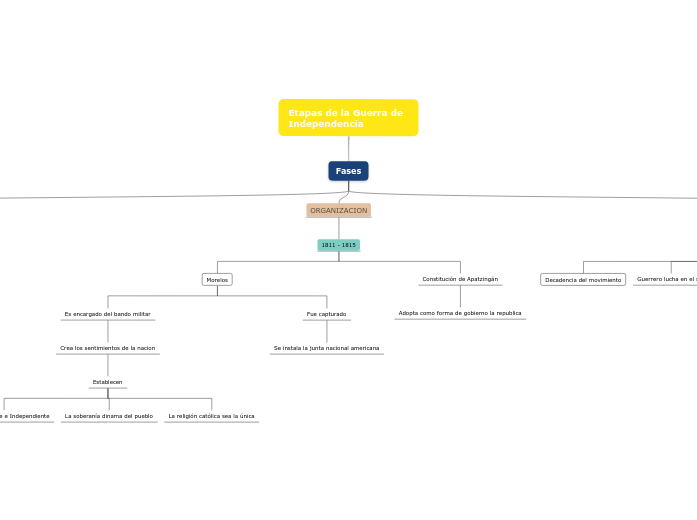by Maia Rivero 3 years ago
332
Etapas de la Guerra de Independencia

by Maia Rivero 3 years ago
332

More like this
Type in the name of the multiple-perspectives text.
Example: Bridge to Terabithia by Katherine Paterson
Identify an important issue from the text that is being presented from different angles. Type it in.
Example: Jesse's drawing talent.
Whose character does the third point of view belong to?
Type in his/her name.
Example: Mr. Aarons, Jesse's father.
What does the character think, say or do that suggests their perspective on the issue?
Type in a quote and try to maintain the citation format.
Example: 'He would like to show his drawings to his dad, but he didn't dare. (...) He'd thought his dad would be pleased. He wasn't. What are they teaching in that damn school? he had asked.' (Paterson, 2.8)
Acta de Independencia
Entrada del ejercito Trigarante
Plan de Iguala
Señala
Gobierno Monárquico
La absoluta Independencia
La religión católica, apostólica y cristiana
Guerrero lucha en el sur
Decadencia del movimiento
What kind of narration introduces the viewpoint?
Choose an answer:
Decide on the second point of view
Name the character (it can either be the main character or one of the supporting characters) whose point of view you are presenting.
Example: Miss Edmunds, Jesse's music teacher.
Type in a quote that points out the character's position about the issue.
Try to follow a citation format: author's name, chapter, and page.
Example: 'She said he was unusually talented, and she hoped he wouldn't let anything discourage him.' (Paterson, 2. 8)
Constitución de Apatzingán
Adopta como forma de gobierno la republica
Morelos
How is the viewpoint introduced in the story?
Choose an answer:
Fue capturado
Se instala la junta nacional americana
Es encargado del bando militar
Crea los sentimientos de la nacion
Establecen
La religión católica sea la única
La soberanía dinama del pueblo
América es libre e Independiente
Decide on the first point of view you are going to present.
Type in the name of the character (it can either be the main character or one of the supporting characters) whose point of view belongs to.
Example: Jesse Oliver Aarons, Jr., the main character of the novel, a fifth-grader living in a rural Southern area.
Type in a relevant quote that highlights the character's point of view towards
Fases.
Try following a citation format: author's name, chapter, and page.
Example: 'Jesse drew the way some people drank whiskey. (...) Lord, he loved to draw. (...) When he was in first grade, he told his father that he wanted to be an artist when he grew up.' (Paterson, 2. 7)
Artesanos, mineros y campesinos
Se integran a los insurgentes
Asesisan a españoles
Saquean a los pueblos
Miguel Hidalgo
What type of narration introduces the viewpoint?
Choose an answer:
Es jefe del movimiento
Da el grito de dolores
es fusilado junto con Allenden